We need your consent to use the individual data so that you can see information about your interests, among other things. Click "OK" to give your consent.
ASTM D8200-22
Standard Practice for Creating a Correlation to Compare Particle Size Distribution Results of Proppants by Dynamic Imaging Analyzers and Sieves
Translate name
STANDARD published on 1.11.2022
The information about the standard:
Designation standards: ASTM D8200-22
Publication date standards: 1.11.2022
SKU: NS-1089380
The number of pages: 7
Approximate weight : 21 g (0.05 lbs)
Country: American technical standard
Category: Technical standards ASTM
Annotation of standard text ASTM D8200-22 :
Keywords:
correlation fit file, dynamic imaging, particle size, proppant,
Additional information
| Significance and Use |
|
5.1?The ability to correlate results of analyzers to sieve sets enables the use of non-sieve methods to be employed that give comparable results to each other. 5.2?The use of analyzers for proppant measurement has the benefit of providing particle shape characteristics which are important in the performance of these materials. Shape analysis is currently done by operators determination based on a visual observation of a small number of particles per API 19C. Available information from imaging analysis of many particles can be used to assess the proppant shape characteristics as opposed to just a small number. |
| 1. Scope |
|
1.1?This practice describes procedural steps to create a correlation that can be used to compare results of proppant size distributions between dynamic imaging analyzers (analyzers) and prescribed sieve sets. 1.2?The proppant size and distribution specifications that are included in this practice are listed in API Standard 19C (API 19C) and shown in Table 1, however as industry evolves additional specifications may come into use and this practice can be used with those as well. 1.3?This practice may not be applicable to all proppant types and designations. The acceptability of the correlations determined are judged by the operator. 1.4?The values stated in SI units are to be regarded as the standard, except sieve designations are typically identified using the alternative system in accordance with Practice E11, such as 3 in. and No. 200 instead of the standard system of 75 mm and 75 ?m, respectively. 1.5?Observed and calculated values shall conform to the guidelines for significant digits and rounding established in Practice D6026, unless superseded by this standard. 1.5.1?The procedures used to specify how data are collected/recorded and calculated in Practice D6026 are regarded as the industry standard. In addition, they are representative of the significant digits that generally should be retained. The procedures used do not consider material variation, purpose for obtaining the data, special purpose studies, or any considerations for the users objectives; and it is common practice to increase or reduce significant digits of reported data to be commensurate with these considerations. It is beyond the scope of these test methods to consider significant digits used in analysis methods for engineering data. 1.6?This practice offers a set of instructions for performing one or more specific operations. This document cannot replace education or experience and should be used in conjunction with professional judgment. Not all aspects of this practice may be applicable in all circumstances. This ASTM standard is not intended to represent or replace the standard of care by which the adequacy of a given professional service must be judged, nor should this document be applied without consideration of a projects many unique aspects. The word Standard in the title means only that the document has been approved through the ASTM consensus process. 1.7?This standard does not purport to address all of the safety concerns, if any, associated with its use. It is the responsibility of the user of this standard to establish appropriate safety, health, and environmental practices and determine the applicability of regulatory limitations prior to use. 1.8?This international standard was developed in accordance with internationally recognized principles on standardization established in the Decision on Principles for the Development of International Standards, Guides and Recommendations issued by the World Trade Organization Technical Barriers to Trade (TBT) Committee. |
We recommend:
Technical standards updating
Do you want to make sure you use only the valid technical standards?
We can offer you a solution which will provide you a monthly overview concerning the updating of standards which you use.
Would you like to know more? Look at this page.




 Cookies
Cookies
